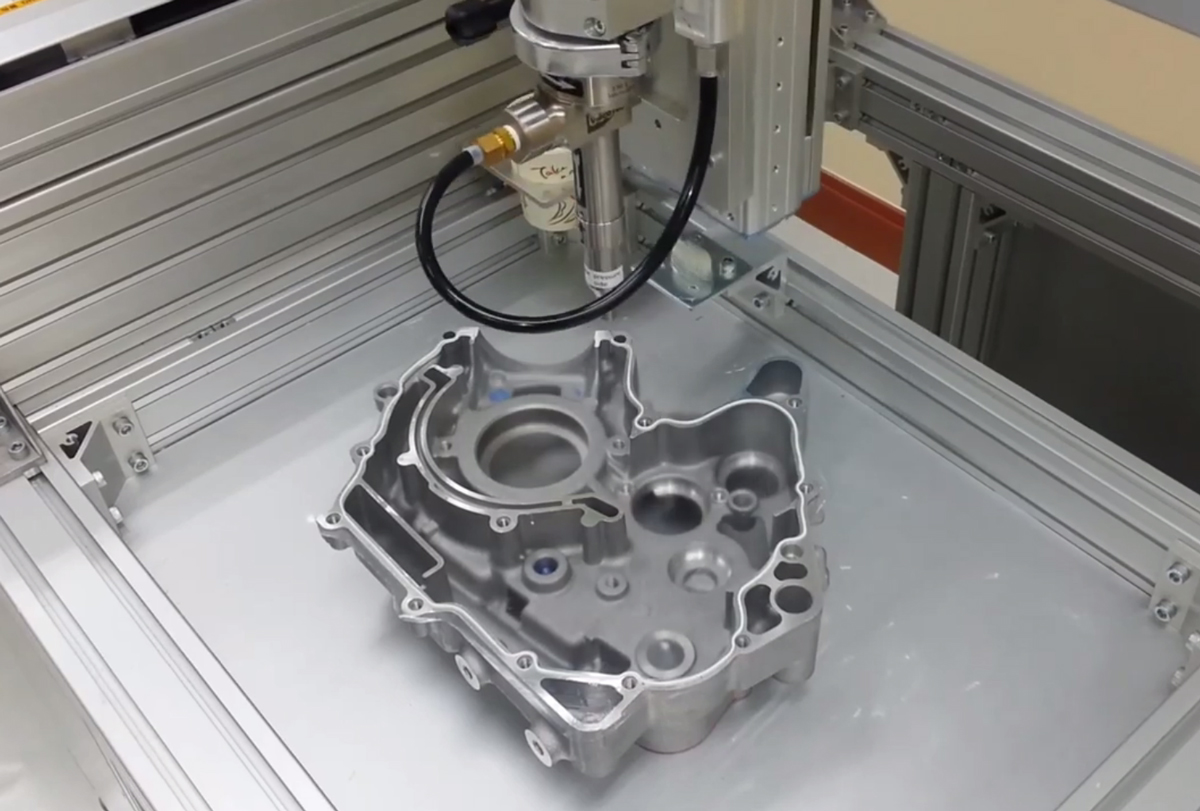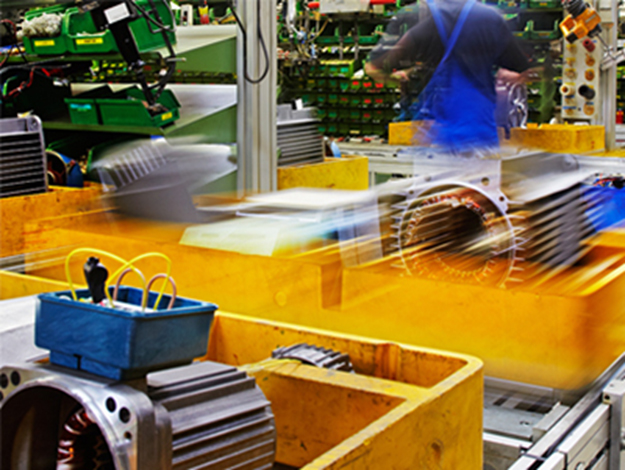The world’s manufacturers are more dependent than ever on high-speed automation to address today’s productivity challenges. However, raising output while maintaining quality is increasingly difficult using conventional automation. Increasing the speed of a process such as coating or dispensing can challenge accuracy and repeatability, demanding complicated fine-tuning to achieve the desired quality at the end of the line. Usually only a small number of skilled and experienced technicians are capable of setting up and maintaining such processes, which can slow the introduction of new products and leave assembly lines vulnerable to stoppages.
High-Productivity, Precision Coating
Yamaha Robotics’ experience working with customers in various industries such as automotive, electronics and medical fields, among others, offers some insights. Depositing sealant along the mating edges of metal castings or plastic components like covers and enclosures, prior to assembly, is a common requirement frequently addressed using conventional drives to coordinate linear movement and sealant dispensing.
To deposit a continuous bead of sealant, the motion-control system must accurately follow a pre-determined path along straight edges and at corners. The speed must typically be reduced at corners to trace the desired locus accurately. On the other hand, raising the speed is desirable when moving along straight edges, to reduce the overall time to complete the process.
To ensure a consistent volume of sealant is deposited in all locations, the dispensing mechanism must be controlled to throttle the flow of sealant in the slow-speed corners and increase delivery when the drive is moving more quickly. This is difficult to achieve, leaving companies dependent upon a small number of staff that have the necessary knowhow. If setup poorly, inconsistencies such as excessive sealant volume at corners can occur, ultimately leading to more rejected units at the end of the line. On the other hand, setting a constant slow drive speed and dispense rate can simplify control of the process, at the cost of longer tact time and lower overall throughput.
Typically, manufacturers want to achieve both high quality and high speed without relying on specialised skills. This calls for a solution that can automatically adjust the sealant-dispense rate as the excursion speed changes, enabling the desired volume of material to be applied at the maximum possible speed that is appropriate at any position.
Automating with Robots
Various industries are now adopting robotic automation to increase productivity and ensure future-proof flexibility. Yamaha Robotics has additionally engineered ease of use into its RCX series of robot controllers and associated graphical programming tools, to help users maximise the advantages of this technology.
The Yamaha RCX340 controller supports enhanced motion capabilities and simplifies robot dispenser setup. In particular, the dispensing-control function can be linked to servo control, enabling the RCX340 to control the dispense rate in conjunction with the moving speed to ensure high precision, high speed, and stable coating thickness. This “servo-linked dispensing” (figure 1) is applicable to Yamaha SCARA robots and cartesian robots.

Figure 1; Yamaha enhanced servo-linked dispensing function with RCX340 controller
In addition, the controller allows easy linking of multiple robots to be controlled simultaneously and supports an extended instruction set, which includes dedicated vision instructions that simplify programming and help minimise equipment startup time. The RCX STUDIO 2020 programming environment contains debugging functions that support multiple tasks and provides features to accelerate program input and enable rapid setup.
Moreover, leveraging communication interfaces commonly used throughout industrial automation permits easy integration in an existing factory environment. In addition to RS-232C and Ethernet ports, the RCX340 supports popular fieldbuses such as CC-Link, EtherNet/IP™, DeviceNet™, PROFIBUS, PROFINET, and EtherCAT. Connections with general-purpose servo amplifier or third-party vision systems are also easily implemented and simplify introducing robot technology to legacy manufacturing processes.
High-Speed Coating in Practice
Yamaha Robotics recently helped a customer in the automotive sector to accelerate precision deposition of liquid sealants on aluminium castings using the RCX340 controller and Yamaha robots. This manufacturer had been unable to raise output by increasing the drive speed of the existing automatic dispense system. Simply increasing the speed had compromised control of the sealant dispensing, resulting in large clumps of sealant in positions where the drive speed was slower. This had forced the company to operate the equipment at constant speed, resulting in slower tact time.

Figure 2. Manufacturers in the automotive sector need to combine high productivity with extremely high quality.
Seeking a faster solution that would also be easy to setup without recourse to skilled technicians, the project-team leader contacted Yamaha to find out if robot technology could provide a practicable alternative. After seeing Yamaha’s demonstration of servo-linked dispensing, he quickly installed a test system at the factory to explore its potential.
“It was clear to see that the production speed was increased and our analysis showed that the coating quality was perfect, too,” he comments, adding, “We also consulted Yamaha on the dispensing process, which we had previously setup using our own in-house experience. The additional expertise helped us calculate optimal settings extremely quickly, significantly reducing the workload on our own engineers.”
Confident of achieving the desired increase in speed as well as stable quality, the project team moved forward to final verification and subsequently introduced the process on the assembly line. As soon as they completed their work, they began exploring opportunities to use Yamaha robots to improve other processes in the factory.
Conclusion
Manufacturers in automotive and other sectors need to adopt advanced automation to reduce cycle times and maintain quality, seeking to further increase productivity. Robots can meet these requirements when combined with the latest motion-control techniques as well as convenient tools to assist programming and setup. Ease of use is essential, to help users quickly introduce the new processes into their factory environment.
About YAMAHA Robotics FA Section
Yamaha Factory Automation Section (FA Section), a subdivision of Yamaha Motor Robotics Business Unit in Yamaha Motor Corporation, is focused on delivering flexible, high-accuracy industrial robots for precision automation challenges.With its roots in the introduction of robot technology to Yamaha motorcycle assembly activities, the division has over 40 years’ experience solving automation challenges from factory-scale to micron-level. Yamaha’s industrial robots are now trusted by leading corporations worldwide, in activities as diverse as semiconductor fabrication and assembling electronic products, domestic appliances, automotive components, and large liquid-crystal panels.
Yamaha FA Section offers a unified range of solutions for robotic assembly, including single-axis robots, SCARA, cartesian, and articulated robots. Innovations such as the LCM100 linear conveyor module; a smoother, space-saving and more versatile successor to conventional belt and roller conveyors continue to set the pace in factory automation. Core robotic technologies as well as key components and complete robot systems are all produced in-house, ensuring consistent quality and control over lead-times.
Headquartered in Hamamatsu, Yamaha FA Section serves customers globally through its worldwide sales network spanning China, Taiwan, Korea, south Asia, north America, Australia/New Zealand, and Europe.
www.yamaha-motor-im.eu
Contact info
Oumayma Grad
Marketing Communications Manager
Hansemannstraße 12
41468 Neuss
Germany
Office: +49 2131 2013 538
Mobile: +49 1517 0233 297
Fax: +49 2131 2013 550
Email: oumayma.grad@yamaha-motor.de
Web: www.yamaha-motor-im.eu
